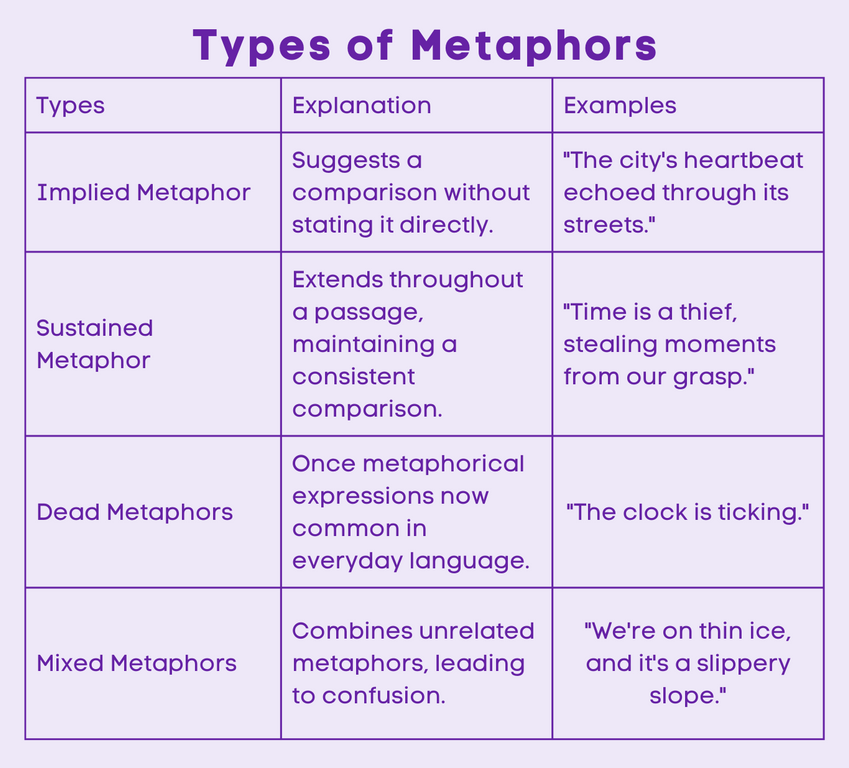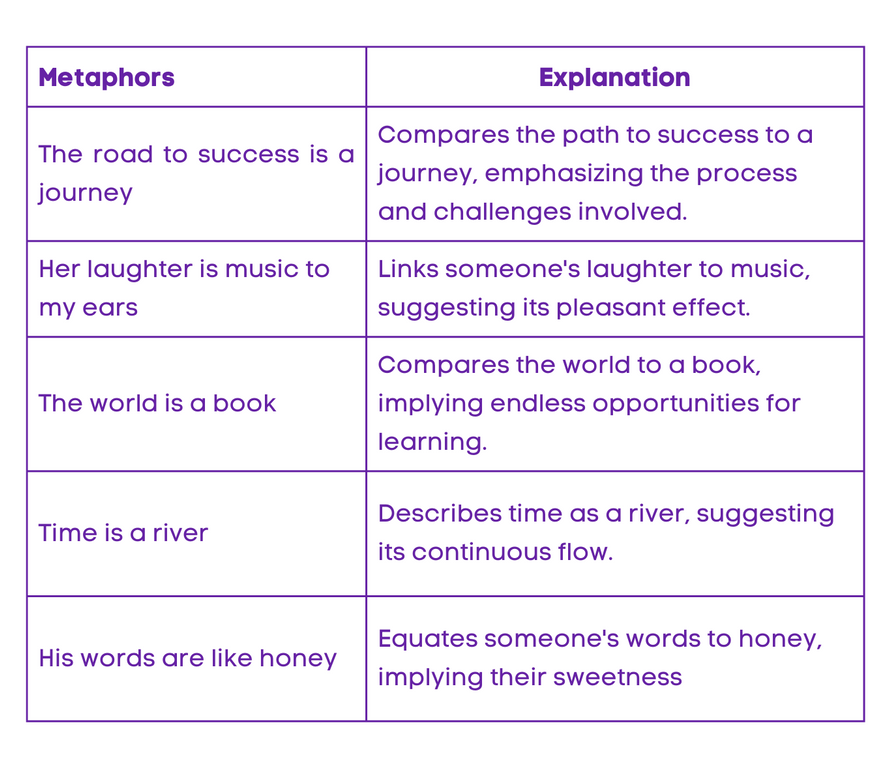Metaphors: A Guide to Understanding and Using Metaphorical Language
Table of Contents
Introduction
Metaphors
Metaphors are a powerful form of figurative language that allow us to convey complex ideas and emotions by drawing comparisons between two unrelated things. They are used to create vivid imagery, evoke emotions, and add depth to our communication. In this article, we will delve into the world of metaphors, explore their types, and understand their significance in language and literature.
Analogy of Definition
What are Metaphors?
A metaphor is a figure of speech that directly refers to one thing by mentioning another. It asserts that one thing is another thing, not just that one is like another. For example, “The world’s a stage” is a metaphor that implies that life is like a play, with its own characters, plot, and drama.
Method
Types of Metaphors
Metaphors can take on various forms, each serving a unique purpose in language and literature.
1. Implied Metaphor: This type of metaphor does not explicitly state the comparison but implies it through the use of figurative language. For example, “The classroom was a zoo” implies chaos and noise without directly stating it.
2. Sustained Metaphor: A sustained metaphor is one that is extended throughout a piece of writing or speech, creating a consistent comparison. It is often used to develop a theme or convey a deeper meaning. For example, in Shakespeare’s “All the world’s a stage” speech, the metaphor of life as a play is sustained throughout the passage.
3. Dead Metaphor: A dead metaphor is one that has become so common in language that its original figurative meaning is no longer apparent. For example, “time flies” is a dead metaphor, as it is used to convey the passage of time without the listener necessarily visualizing flying.
4. Mixed Metaphor: A mixed metaphor occurs when two or more metaphors are jumbled together, often resulting in a confusing or nonsensical comparison. For example, “We’ll burn that bridge when we come to it” combines the metaphors of burning bridges and crossing them, leading to a mixed and illogical comparison.

Similes vs Metaphors
While both similes and metaphors are used to make comparisons, they differ in their approach. A simile directly compares two things using the words “like” or “as,” while a metaphor implies a direct comparison without using these words. For example, “He is as brave as a lion” is a simile, whereas “He is a lion” is a metaphor.
A simile, such as “He is as brave as a lion,” draws a comparison between someone’s courage and the bravery of a lion. It employs “as” or “like” to highlight the similarity without directly stating that the person is a lion. On the other hand, a metaphor, like “He is a lion,” directly asserts that someone embodies the qualities of a lion, such as courage, strength, or leadership. While both similes and metaphors create figurative comparisons, similes maintain a clear distinction between the subject and the object of comparison, whereas metaphors assert a direct equivalence between them.
Metaphor vs Analogy
While both metaphors and analogies are used to make comparisons, they differ in their structure and purpose. A metaphor directly equates one thing with another, while an analogy compares the relationship between two pairs of things. For example, “Life is a journey” is a metaphor, while “Just as a caterpillar comes out of its cocoon, so we must come out of our comfort zone” is an analogy.
In the statement “Life is a journey,” a metaphor is employed to directly assert that life shares qualities with a journey. It implies that life involves movement, experiences, and various stages, akin to a journey from one place to another. Metaphors like this create a direct comparison between the two concepts without using “like” or “as.”
On the other hand, the statement “Just as a caterpillar comes out of its cocoon, so we must come out of our comfort zone” is an analogy. Analogies compare two different things or situations to highlight similarities between them. In this analogy, the process of a caterpillar emerging from its cocoon is compared to the idea of stepping out of one’s comfort zone. The analogy suggests that, like the caterpillar undergoing transformation, we also need to undergo personal growth by leaving behind familiarity and embracing change. Analogies often use “just as… so” or “like… so” structures to draw parallels between concepts or situations.
Examples
1. “Time is a thief” – This metaphor implies that time steals moments and experiences from us.
2. “The world is a book, and those who do not travel read only one page” – This sustained metaphor compares the world to a book, with each travel experience being a new chapter.

Quiz
Tips and Tricks
1. Understanding Implied Metaphors
Tip: Look for words and phrases that suggest a comparison without directly stating it. Implied metaphors often use figurative language to convey a deeper meaning.Implied metaphors subtly hint at a comparison between two things without explicitly stating it. Instead, they rely on figurative language, such as symbolism or descriptive language, to convey a deeper meaning. Readers must infer the comparison based on context and the associations evoked by the words and phrases used.
2. Crafting Sustained Metaphors
Tip: When using a sustained metaphor, ensure that the comparison is consistent and contributes to the overall theme or message of your writing. A sustained metaphor is a metaphor that extends throughout a passage, paragraph, or even an entire work. When crafting sustained metaphors, it’s essential to maintain consistency in the comparison and ensure that it reinforces the central theme or message of the writing. This helps to create coherence and depth in the narrative or argument.
3. Recognizing Dead Metaphors
Tip: Be aware of common phrases and expressions that were once metaphors but have lost their figurative meaning through overuse. Dead metaphors are expressions that were originally metaphorical but have become so commonly used that their figurative meaning is no longer recognized. While they may have once evoked vivid imagery or comparisons, dead metaphors are now treated as ordinary language. It’s important for writers to recognize dead metaphors to avoid using them in ways that no longer resonate with readers.
4. Avoiding Mixed Metaphors
Tip: When using metaphors, ensure that you maintain a clear and coherent comparison without mixing multiple metaphors that may confuse the reader. Mixed metaphors occur when a writer combines two or more unrelated metaphors within the same expression or sentence. This can lead to confusion and undermine the effectiveness of the comparison. To avoid mixed metaphors, writers should ensure that their metaphors are consistent and coherent, focusing on one central comparison to convey their intended meaning clearly.
5. Differentiating Metaphor and Analogy
Tip: Remember that a metaphor directly equates one thing with another, while an analogy compares the relationship between two pairs of things. Metaphors directly assert a comparison between two seemingly unrelated things, equating one with the other to convey a deeper meaning or insight. In contrast, analogies compare the relationship between two pairs of things to illustrate a similarity or parallel. Understanding the distinction between metaphor and analogy helps writers choose the most appropriate rhetorical device for conveying their ideas effectively.
Real life application
Metaphors are not just confined to literature; they play a significant role in our everyday communication and understanding of the world.
Scenario 1: The Journey of Life
When we describe life as a journey, we are using a metaphor to convey the idea that life is filled with twists, turns, and milestones. This metaphor helps us make sense of our experiences and provides a framework for understanding the passage of time.
Scenario 2: The Language of Love
In the realm of relationships, metaphors are often used to express emotions and experiences. Phrases like “You are the light of my life” and “Love is a battlefield” use metaphors to convey the depth and complexity of human emotions.
Scenario 3: The World of Business
Metaphors are frequently employed in the business world to communicate complex ideas and strategies. Terms such as “climbing the corporate ladder” and “thinking outside the box” use metaphors to convey concepts of advancement and innovation.
FAQ's
Like? Share it with your friends






